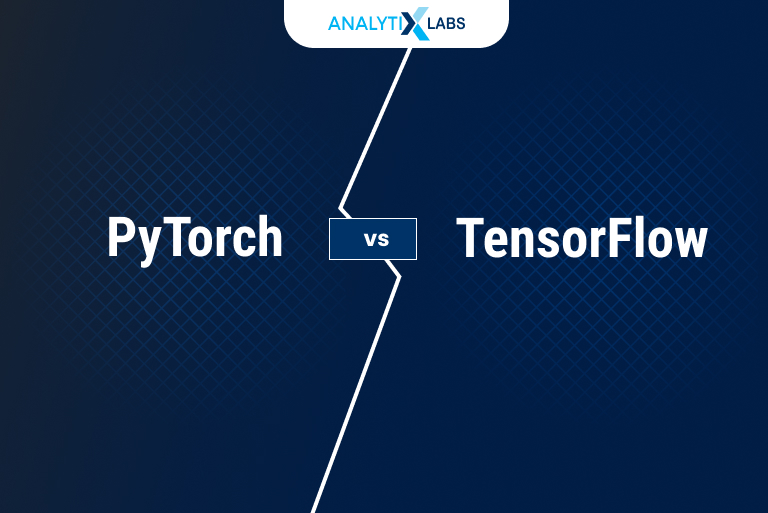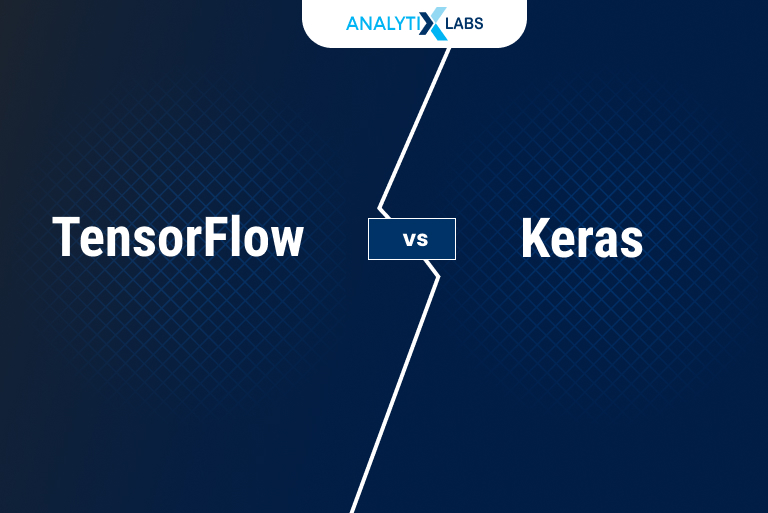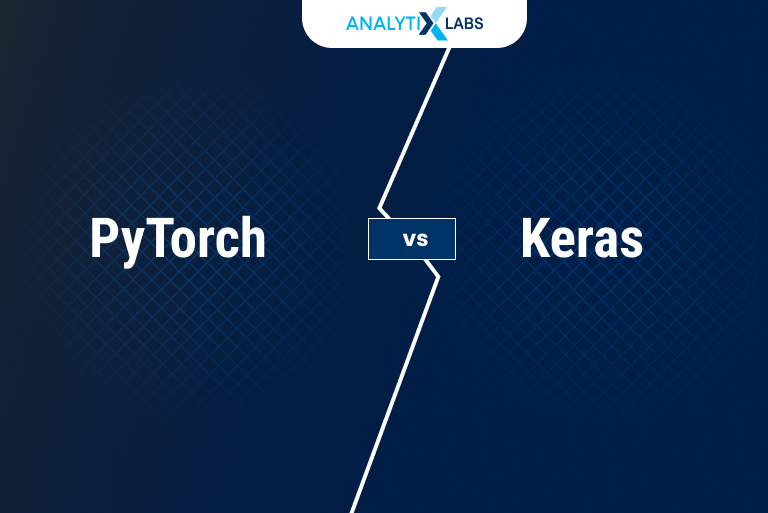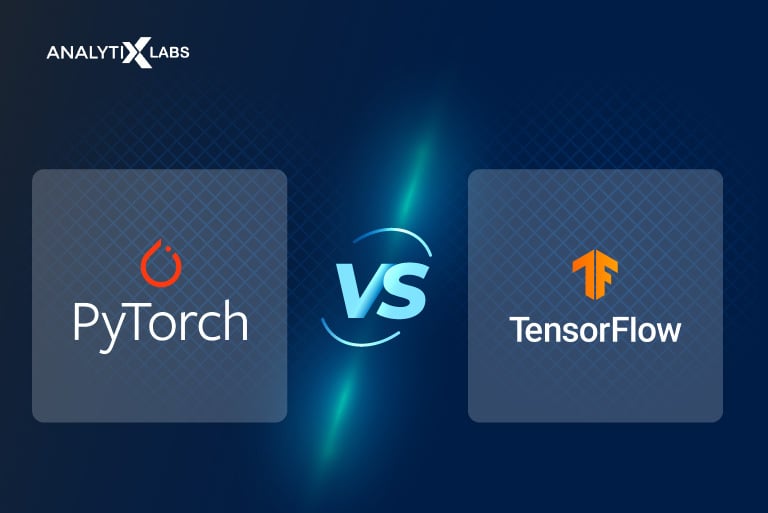PyTorch and TensorFlow are two major deep-learning frameworks. They have become prevalent among data scientists, machine learning engineers, and researchers due to their ease of use, ability to scale with complexity, and open-source nature. However, you should consider several factors when deciding between PyTorch vs. TensorFlow – two powerful platforms for your next project or model training effort.
PyTorch, developed by Facebook’s AI research lab, offers a flexible and efficient framework for building and training deep learning models in computer vision, Natural Language Processing (NLP), and reinforcement learning.
On the other hand, TensorFlow, created by Google, provides a comprehensive suite of tools and resources for developing and deploying machine learning models. These libraries have gained widespread adoption, boasting active communities, extensive documentation, and pre-trained models.
With their powerful capabilities, PyTorch and TensorFlow have become indispensable tools for researchers and practitioners seeking to harness the potential of machine learning.
This article will review PyTorch vs TensorFlow side by side so you can make an informed decision based on their differences.
Before diving into the details of TensorFlow vs PyTorch, let us briefly examine deep learning.What is Deep Learning?
Deep learning is a subset of artificial intelligence that enables computers to think and learn as humans do. It processes complex data and patterns to produce accurate insights. It is generally used to automate tasks that require human intelligence.
Deep learning algorithms use neural networks that are modeled after human brains. The human brain constitutes several interconnected neurons that work together to learn and process information.
Likewise, deep learning has several layers of artificial neurons that work together in a computer. Artificial neurons are the software modules or nodes that play a vital role in solving complex problems.
Also read: Understanding Perceptron: The Founding Element of Neural Networks
Deep learning algorithms learn from data by forming complex non-linear relationships between its features, making it suitable for object recognition, natural language processing (NLP), and reinforcement learning.
Its applications range from autonomous driving to medical diagnostics. Deep Learning is also important in emerging technologies such as fraud detection, virtual reality, and robotics.
Some uses of deep learning are as follows:
- Image and facial recognition for surveillance systems.
- Speech recognition for virtual assistants such as Google Home and Alexa.
- Natural language processing (NLP) to understand the intent of complex queries or commands.
- Autonomous driving makes cars drive themselves safely on roads.
- Medical diagnostics for early disease detection.
- Reinforcement learning enables robots to interact with their environment.
Let us understand the three most important frameworks – PyTorch, Keras, and TensorFlow.Also read: Difference between Machine Learning, Pattern Recognition, and Data Mining
Before that, take a look at our tailored courses on Machine Learning and AI Engineering. ⬇️
You can opt for classroom, online, or self-paced learning for a convenient and smooth learning experience. We help you decide which course is ideal for you, guide you throughout your learning journey, and ensure that you get onboard with your dream company after you complete our course.
Book a demo with us and let us help you make the right choice.
What is PyTorch?
PyTorch is an open-source deep-learning library based on Python and Torch. It provides a versatile platform for building and training neural networks in computer vision, natural language processing (NLP), and reinforcement learning.
Developed in 2016 by Facebook’s AI research lab, PyTorch has gained popularity, providing researchers and developers with a flexible and efficient framework for constructing and training deep learning models. It has grown popular due to its simplicity of use, intuitive API, extensibility, scalability, and ability to support production deployment.
-
Features
A distinctive feature of PyTorch is its dynamic computational graph, allowing developers to construct and modify graphs on the go. Unlike static graph-based frameworks, this flexibility enables intuitive model creation, easier debugging, and architectural experimentation.
Developers can quickly iterate on ideas with minimal overhead. Additionally, it enables researchers to replicate experiments and create new ones from scratch easily.
PyTorch’s Pythonic style integrates smoothly with the Python ecosystem, leveraging its libraries and tools for simplified code development, debugging, and interoperability with other frameworks.
PyTorch includes TorchVision, a high-level interface featuring pre-trained models, datasets, and image transformation functions. It simplifies tasks like image classification, where renowned Convolutional Neural Network models such as ResNet, VGG, and AlexNet can be readily employed.
GPU acceleration is another standout attribute of PyTorch. Leveraging the power of graphics processing units (GPUs) enables faster training and inference by performing efficient computations.
The PyTorch community is vibrant and active, offering abundant tutorials, documentation, and online resources. This extensive support ecosystem facilitates a smooth learning curve for newcomers, allowing them to grasp and utilize the library’s capabilities quickly.
What is TensorFlow?
TensorFlow is an open-source machine-learning platform developed by Google. It offers a comprehensive suite of tools and resources for developing and deploying machine learning models. Additionally, it provides an extensive library of pre-trained models that can be used to build new applications quickly.
TensorFlow is designed to facilitate quick experimentation while allowing production model deployment. It has many advantages over traditional machine-learning approaches, such as working across multiple platforms (including mobile devices), distributed training and inference support, and easy integration with other libraries.
-
Features
At its core, TensorFlow revolves around computational graphs. Developers can define intricate mathematical computations as interconnected nodes representing operations or variables. These nodes form a graph where mathematical operations are performed, and data flows through the edges.
With TensorFlow, building machine learning models becomes flexible and scalable. It supports various neural network architectures, such as convolutional neural networks (CNNs), recurrent neural networks (RNNs), and transformers. Additionally, TensorFlow provides APIs for reinforcement learning, natural language processing, and time series analysis.
An essential feature of TensorFlow is its ability to harness hardware acceleration, including GPUs and TPUs (Tensor Processing Units). This hardware optimization expedites computations, resulting in faster training and inference for deep learning models, particularly when working with extensive datasets.
The TensorFlow community is substantial and dynamic, offering many resources, tutorials, and pre-trained models. High-level APIs like Keras further enhance TensorFlow’s accessibility, providing a simplified interface for model construction and training, catering to both novices and experienced developers.
What is Keras?
Keras is an open-source neural network library written in Python. It includes a user-friendly API for implementing neural network tests. Keras is designed to be intuitive, modular, and extensible.
It offers a simple API for creating neural networks that can be easily customized and reused for different tasks. Additionally, Keras provides access to TensorFlow’s low-level operations, which enables users to customize their models even further.
Keras has ten variants of neural network modeling and training modules that can run on CPUs and GPUs. With Keras models, developers can easily build complicated neural networks.
There are two primary types of Keras models:
- Keras’s sequential model enables users to develop models in layers piled upon one another with single inputs and outputs. It works well for a basic layer stack with only one input and output. However, it is not suitable for non-linear topology. It is because the paradigm fails if any of the stack layers have multiple inputs or outputs.
- Keras Functional API is a data structure that can create models with multiple inputs and outputs. You can also use it to construct layer graphs. It can be saved as a single file and used to rebuild a model without knowing the source code.
PyTorch vs. TensorFlow

Comparing PyTorch vs TensorFlow is an important decision for any aspiring deep learning developer. Both are open-source and powerful frameworks with sophisticated capabilities, allowing users to create robust neural networks for research or production purposes. Although both platforms offer a wide range of features, there are some differences between PyTorch and TensorFlow.
Regarding speed and flexibility, PyTorch offers more dynamic computational graphs than TensorFlow. TensorFlow does its graph computations as static operations, which can not be modified once set up.
At the same time, PyTorch allows you to modify the graph on the go, giving you much more control over your model’s training process. It makes PyTorch a more suitable choice for projects that need to adjust their architecture during training.
However, TensorFlow has been engineered to perform better on larger datasets and can handle distributed computing tasks more efficiently than PyTorch.

TensorFlow vs. Keras
When it comes to choosing between TensorFlow vs Keras, there are a few key differences that should be considered.

TensorFlow is an open-source machine-learning library developed by Google. It is often used for advanced tasks such as large-scale image recognition and natural language processing.
It has many applications, from creating deep neural networks to training AI agents in reinforcement learning environments. TensorFlow offers powerful building blocks, including neural network layers, convolutional layers, pooling layers, optimization functions, and activation functions.
Furthermore, it allows developers to construct their models using these blocks or take advantage of existing pre-trained models available on the web.
Related read: Machine Learning vs. Deep Learning
Keras is a high-level neural network library that runs on top of TensorFlow, Theano, or CNTK. It allows developers to build complex networks with fewer lines of code and provides an intuitive way to design and train deep learning models.
Keras also offers helpful features such as automatic selection of the best optimization technique for a given task, easy integration with other libraries like OpenCV and Scikit-learn, and support for multiple backends, including TensorFlow.
Additionally, Keras abstracts away many tedious tasks from developers so they can focus on the higher-level aspects of their model development.
Also read: What is Data Strategy?

Overall, the Keras TensorFlow debate concludes that both offer powerful tools for developing efficient machine-learning applications. Depending on your project goals and requirements, you may find one more suitable than the other.
For instance, TensorFlow would be the better choice if you need a high degree of flexibility in constructing your models. On the other hand, if you want to build and train complex neural networks quickly, then Keras is ideal.
PyTorch vs Keras
Pytorch and Keras are both popular open-source deep-learning libraries. Both libraries offer powerful capabilities for building complex neural networks and other machine learning models.

When comparing Pytorch vs Keras, it is important to consider the type of model you plan to build and your existing programming skillset. Both libraries have pros and cons, so it is worth weighing the differences before deciding.
Pytorch is a framework for building dynamic computation graphs written in Python. At the same time, Keras is a high-level library that provides an easier way to define neural networks using only a few lines of code.
Pytorch offers dynamic graphs, which means the structure of a network can be changed during runtime, giving you greater flexibility when building models. This makes it a better choice for more complex architectures and projects that require custom components.
Keras is easier to use than Pytorch, as its syntax allows for quicker model development while providing good performance and accuracy.
Regarding debugging and troubleshooting, Pytorch has an advantage over Keras due to the ability to modify the graph structure at any time. On the other hand, Keras often requires extra setup before a model can be used in production due to its high-level nature.

Finally, when comparing the performance between Pytorch vs Keras, it is important to remember that the choice of a library should not be the primary factor influencing performance. Both libraries have been benchmarked for various tasks and generally perform well. Ultimately, it comes down to your preference when selecting a library.
PyTorch vs. TensorFlow vs. Keras
The three main contenders of deep learning frameworks are PyTorch, TensorFlow, and Keras.These frameworks offer powerful tools for building complex neural networks and harnessing the power of modern hardware. However, each has unique strengths and weaknesses that make them better suited for different tasks.
PyTorch is a relatively new deep-learning framework. It is designed to be easy and highly flexible, with features such as dynamic execution graphs and automatic differentiation.
These features make it ideal for rapidly prototyping models or implementing state-of-the-art research ideas. PyTorch also supports distributed training via its API, which makes it easy to scale your models and put them into production.
TensorFlow is a larger and more mature deep learning framework than PyTorch, with extensive documentation and community support. It has been widely used in the industry for large-scale projects.
Its API is one of the most user-friendly ways to create complex neural networks. Additionally, TensorFlow supports distributed computing via its tensorflow/distribute library, making training on powerful hardware like GPUs and TPUs easier.
Keras is a high-level deep learning API that simplifies the creation of complex neural networks. It provides a simple interface for quickly building intuitive models without learning all the details of how TensorFlow works.
Additionally, Keras includes pre-trained models that can be used directly with minimal data preprocessing.

Pros and Cons of PyTorch, TensorFlow, and Keras
Each framework has its unique strengths and weaknesses that make it better suited for different tasks.
- PyTorch is great for rapid prototyping and implementing state-of-the-art research ideas.
- TensorFlow offers excellent documentation, community support, and distributed training capabilities.
- In contrast, Keras provides a user-friendly API for quickly building neural networks without needing to understand all the details of TensorFlow.
Ultimately, the best choice of framework will depend on what your goals are and which features you need. Let us now take a look at the pros and cons of each framework.
-
PyTorch
| Pros | Cons |
|
|
-
TensorFlow
| Pros | Cons |
|
|
-
Keras
| Pros | Cons |
|
|
PyTorch vs. TensorFlow: Practical Differences
We can make use of Python modules in Pytorch. In the code below, we use Python’s numpy module to create arrays and execute multiplication.

TensorFlow has modules for various operations to perform. In the below code, we use “tensorflow” for multiplication.

And that’s a wrap for PyTorch vs. TensorFlow vs. Keras. Let us now look at some commonly asked questions.
FAQs
-
Is PyTorch better than TensorFlow?
PyTorch is better than TensorFlow because its API is more intuitive. PyTorch also has better debugging tools since it supports natively recursive functions, dynamic graphs, and Python code execution. Additionally, it can bring speed benefits due to its dynamic computation graph, which speeds up the development process by allowing developers to focus on the task without worrying about computations first.
-
Is PyTorch faster than TensorFlow?
No, TensorFlow is generally seen as faster for large-scale applications due to its optimized execution engine that uses static graphs. It makes Pytorch more efficient at scheduling operations across multiple GPUs or CPUs.
Additionally, TensorFlow has many mechanisms in place, such as AutoGraph, which can optimize code written in Python and help reduce processing times significantly. But PyTorch has an advanced compiler that allows for faster model execution and many features that can help with speeding up training times.
-
What is the disadvantage of PyTorch?
The main disadvantage of PyTorch is that it can be difficult for beginners to learn and use. It also does not have as much documentation and support resources as other deep learning frameworks, such as TensorFlow.
Furthermore, it has a steep learning curve and requires more manual coding than some of the other deep learning frameworks. Additionally, its debugging capabilities may not be sufficient for larger projects. Finally, PyTorch has limited deployment options for scaling in production environments.
-
Is PyTorch good for AI?
Yes, PyTorch is a great choice for AI. Its open-source Python library provides deep learning algorithms and a wide range of tools that make creating neural networks and powerful AI applications easy.
It has powerful built-in libraries such as torchvision, torchtext, and torchaudio, allowing developers to develop powerful deep-learning models with minimal effort quickly. Additionally, its dynamic computational graph feature enables faster training times.
It makes debugging easier since users can change or add code during runtime without restarting the process from scratch. Furthermore, PyTorch provides excellent documentation, tutorials, and community support so developers can easily get started.








